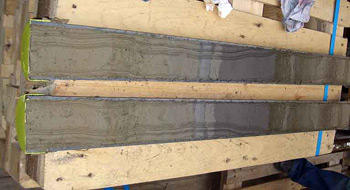Day 19 - 13 July
Before we finish the cruise we hoped to dive to the deepest part of this volcanic rift valley. Is today the day for such a venture? The wind is beginning to increase and the wave height as well … In addition, it is Friday the 13th!
Main content
Position: 73ºN, 7ºE
Temperature: 4.3ºC
Wind speed: 8-10m/s
Wave height: 2.8m
Visibility: good
Weather: partially cloudy
First thing in the morning we dove to 1400m and collected a basalt sample from the northern face of the seamount. As the waves continue to increase in size, we decided to postpone further ROV dives for the time being and instead used the gravity corer. We collected a 2.5m core from 2000m deep. When we split the core open the microbiologists and geologists set to work gathering samples.
The core showed a number of clearly distinct layers; each one representing a chapter in the geological history of this area. The top layers are the most recently deposited sediments, while the lowest layers could have been deposited many thousand years ago. Researchers will date fossil elements within the core sediments to be able to assign a date to the different layers.
Within the core record a distinct gray layer may have been deposited during the last ice age. There are numerous brown layers that may be ash from a volcanic eruption or the brown colour may show the presence of iron and manganese and be evidence of hydrothermal venting.
Around midnight we started to map the seamount using the multibeam echosounder. Things finally become quiet on board. The GOSars makes a pattern of transects over the seamount. In the morning, a new area of the seamount will be accurately mapped. Some people are on watch, others are watching late night films. Some of the researchers are taking advantage of the 24-hour daylight to continue to work in the labs.
